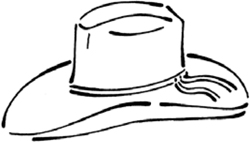Authors: Dan Lewis
Now I Know More (28 page)
In 1893, two sisters from Kentucky, Mildred and Patty Hill, composed a song called “Good Morning to All.” The lyricsâ“Good morning to you / good morning to you / good morning dear children / good morning to all”âare foreign to modern ears. However, the melody the sisters used for the song was that used in “Happy Birthday.”
Sometime over the next few decades, that tune was wed to the lyrics we all know. Nobody knows exactly who wrote the stanza we all sing regularlyâdepending on whom you ask, “Happy Birthday” may be by the same two sisters or it may not have been written for twenty years thereafter. What we do know: the lyrics appeared in a 1924 book, as a second stanza following the original one of “Good Morning to All.” The song appeared in a series of other contexts soon after. In 1935, the company that originally published “Good Morning to All”âworking with the Hills' sister Jessicaâcopyrighted “Happy Birthday.”
Today, the rights are owned by Warner Music Group. Warner continues to enforce the copyright insofar as public and/or for-profit performances are concerned. (Don't worry about singing it at a private family gathering.) Enforcement of the copyright netted the company $2 million in royalties in 2008 alone, and apparently, the Walt Disney Company paid $5,000 to use the song in a ride at Epcot Center a few decades ago.
Some take steps to avoid the fees. For example, some filmmakers substitute “For He's a Jolly Good Fellow” when “Happy Birthday” would otherwise be more appropriate. Perhaps absurdly, in an effort to skirt paying royalties to Warner Music some chain restaurants instruct servers to sing atypical birthday songs when guests celebrate at their establishments.
“Happy Birthday” was originally scheduled to enter the public domain in 1991, but a pair of copyright extension laws in the United States (not specific to this song) extended its copyright another four decades. Absent other extensions, the song will enter public domain in the United States in 2030 and in the European Union at the close of 2016.
In 1963, an artist named Harvey Ball created the iconic yellow smiley face. He did it as a freelancer on behalf of the company now known as Hanover Insuranceâbut neither he nor the company ever registered the artwork with the copyright or trademark offices. Ball made a total of $45 from his creationâthe fee Hanover paid him for the work.

WHY HOLLYWOOD MADE A MOVIE THEY NEVER WANTED YOU TO WATCH
The Fantastic FourâMr. Fantastic, the Invisible Woman, the Human Torch, and the Thingâoriginally appeared in an eponymous 1961 comic book released by Marvel Comics. They were popular for decades and, in 2005, 20th Century Fox released a movie about the heroic quartet, which earned over $330 million at the box office with a $100 million budget. A sequel,
Fantastic Four: Rise of the Silver Surfer
, hit theaters two years later, earning $290 million at the box office with a budget of $130 million. Despite the apparently massive amounts of money these movies made, studio execs were disappointed and put the franchise on hold for nearly a decade. (A rebooted series was planned for 2015 release.)
There's another Fantastic Four movieâbut you've probably never seen it. Technically speaking, it came out in 1994, but it never hit theaters nor had a home video release. To make matters even stranger, the film's producers didn't care at all. In fact, they were probably happy.
In the 1980s, Marvel Comics wasn't yet set up to produce movies. The company ended up licensing some of their characters to various movie studiosâthat's why Spider-Man movies are produced by Sony and the X-Men films are distributed by 20th Century Fox. (Marvel has retained some rightsâmost notably to Iron Man, Captain America, the Incredible Hulk, and the rest of the Avengersâand will regain the rights to their licensed characters at some point, but probably not too soon.) The Fantastic Four were one of the franchises licensed out during that boom period. In 1983, a production company named Neue Constantin purchased the option to create a Fantastic Four movie for what is rumored to be about $250,000.
That option was set to expire on December 31, 1992, and as that date approached, Neue Constantin was nowhere close to having a summer blockbuster readyâa week before that date, they hadn't even started production. Neue Constantin approached Marvel for an extension, but was rebuffed. So they came up with another idea: Make a really terrible movie on the cheap.
The agreement between Marvel and Neue Constantin allowed the latter to retain the rights to the characters so long as they produced a movie before the date in question. The theory behind this ancillary right makes senseâif the production company makes a smash hit, they should be able to produce a sequel. Neue Constantin, many would later argue, used this as a loophole. In September 1992, they brought on a low-budget producer who could quickly churn out a Fantastic Four movie with a budget of only $1 million, chump change by industry standards. Production began on December 28, 1992, a few days before the deadline, and wrapped a month later. The film was slated to come out in late 1993 or 1994 but was scrapped before it hit theaters.
The reasons why are unclear. Stan Lee, the legend behind Marvel, claims that Neue Constantin never intended to release the filmâby simply creating the movie, the production company was able to maintain its hold on the Fantastic Four franchise for years to come. Neue Constantin's executives tell another story, asserting that Marvel executive Avi Arad caught wind of the low-budget flick and, wanting to protect the Fantastic Four brand, bought all the rights and ordered all copiesâincluding the film negativesâdestroyed. (If true, he failed; two decades later, you can find a bootlegged copy on YouTube.)
Either way, Neue Constantin came out ahead. The company retained the rights to the Final Four franchise. If you look at the credits for both the 2005 and 2007 Fantastic Four films, you'll see the name “Constantin Film”âNeue Constantin's new nameâas one of the studios involved in the productions.
On November 17, 1978, on the heels of the box office success of
Star Wars
, CBS aired the first official
Star Wars
spinoff, called “The Star Wars Holiday Special.” The ninety-seven-minute show was a weird variety showâstyle disaster, which was nearly universally panned. In response to the negative reviews, the powers that be decided to never re-air it or release it on home video. Thanks to the magic of the Internet, though, you can find a copy online pretty easily. (But, as someone who has seen it, take my word for it: Don't bother.)

THE GUY WHO WATCHES STAR WARS FOR A LIVING
When the first Star Wars movie,
A New Hope,
debuted in 1977, it introduced a complex universe of planets, species, religions, and ethos, which quickly expanded well beyond the 121-minute-long story of Luke Skywalker's triumph over the Death Star. The original trilogy was later unfortunately expanded by a series of three “prequels.” And there were the cartoons. And toys. And books. And video games. And everything else.
With all of that content come a lot of detailsâdifferent parts of the back stories of dozens of different species and hundreds of different characters, for example. When things get too complicated, many other brands “reboot” their universes, discarding most of the details and retaining just the broad strokes. But those at LucasFilm in control of Star Wars chose a different tactic. They hired Leland Chen.
He's the Keeper of the Holocron.
Really. It says that right on his LinkedIn profile.
Holocrons are, appropriately, fictional devices from the Star Wars universe itself. Wookieepediaâthat's not a typo, but the name of an unofficial Wikipedia-like encyclopedia of Star Wars informationâdefines a Holocron as an “organic crystal-lattice device which stored phenomenal quantities of da
ta guarded
by the device's gatekeeper.” In other words, it's a high-tech library from a long time ago in a galaxy far, far away. The real-life equivalent of the Holocron is the database of Star Wars info that Chen administersâhe'd be considered the gatekeeper, if you wanted to mirror the lexicon.
Chen was hired by LucasFilm in January 2000 to create this database. (His official title is “Continuity Database Administrator,” according to a
Wired
profile.) As he explained on the official Star Wars blog before he joined the company, LucasFilm had binders full of information about the universe, but it was quickly getting unwieldy and therefore difficult for licensees and partners to operate without creating continuity errors. Over the past decade, Chen digitized that information and then started watching movies, reading books, perusing video games, and the rest, all to make the databaseâthe Holocronâas complete as possible. As of 2012, the Holocron contained “over 55,000 entries including over 19,000 characters, 2,900 species, 5,300 worlds, and 2,100 different types of vehicles,” according to a blog post by Chen. He also created a team charged with making sure what was canonical remained consistent. This requires extraordinary attention to detail, as
Wired
pointed out:
Chen spends three-quarters of his typical workday consulting or updating the Holocron. He also approves packaging designs, scans novels for errors, and creates Talmudic charts and documents addressing such issues as which Jedi were still alive during the Clone Wars and how long it takes a spaceship to get from Dagobah, where Yoda trained Luke Skywalker, to Luke's homeworld of Tatooine. The Keeper of the Holocron takes this very seriously: “Someone has to be able to say, âLuke Skywalker would not have that color of lightsaber.'”
When mistakes come up, Chen tries to resolve them or, when need be, make retroactive changes to maintain continuity. (There's even a term for thisâ“retcon.”) However, that's not always possible. Some of the early works are too complicated to fix retroactivelyâtake the widely maligned Star Wars Holiday Special from 1978 or the first Star Wars novel,
Splinter of the Mind's Eye
(where Luke and Leiaâsiblings who don't know it yetâget a little frisky). Those are treated as outliers.
But the big category of outliers is flagged GWL. This is the stuff that drives hardcore Star Wars fans mad. For example, R2-D2 could fly in the prequels, but he forgot about that ability in the original trilogy. Both R2 and C3P0 served Obi-Wan Kenobi in the Anakin Skywalker stories, but in
A New Hope
, Obi-Wan had no knowledge of either of the droids, or vice versa. That stuff is all GWL. GWL is the only force more powerful than the Holocron.
GWL stands for George Walton Lucas.
You won't find the name of Yoda's species or its home planet in the Holocron. The former has never been named and the latter has never been identified.
In the summer of 2013, Star Wars debuted once more, and again in groundbreaking fashion. On July 3rd,
Star Wars Episode IV: A New Hope
became the first major motion picture to be translated and dubbed into Navajo, as part of an effort to keep the dying Native American language alive for another generation. As NPR reported, the Navajo version was screened at the Navajo Nation Fair in Window Rock, Arizona, and is now available on DVD.


